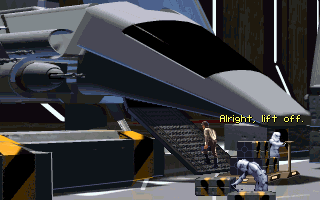Darth Wong wrote:Coalition wrote:Forcefields do have a few advantages. They can be activated much faster, compared to blast doors taking time to close.
They can also be deactivated much faster and easier.
Also, forcefields can be hidden in the walls, while blast doors would have recessed areas where they can spring out from.
Small projector devices = fragility.
Forcefields can also be computer controlled for shape, allowing people to program a computer with the necessary field 'geometry', and change the flat field protecting them into a set of stairs to get to safety.
Great idea; entrust the very shape of your artificial world to
software.
Blast doors would leave the person stuck. This was used in a DS9 episode, with Dax.
You'll need to present more concrete evidence than "a DS9 episode" in order to show why any sane person would go with forcefields in a mission-critical application.
So Forcefields would be used first to seal off an area, then blast doors would take over the strain.
A fine idea as long as the forcefields are not relied upon excessively.
Both technologies have their uses.
Of course both technologies have their uses. But if you're going to pick one, I'd much rather be behind a blast door than a forcefield.
Pretty much all of the above is due to my lack of communications.
For the forcefields being shut down much faster, I agree. I was visualizing Force fields being activated first, with a blast door sealing behind them. he force fields provide initial protection/atmosphere containment, and the blast doors seal the place closed. Of course, they would be on different circuits. After the blast doors seal, the fields would likely be deactivated, to save power.
For speed of forcefields vs blast doors, in ANH, I remember that fast closing door behind Luke & Leia (in front of the bottomless pit), and the slow blast doors that han dived through as they were closing. The first seemed more like a door to a room, and the second was an actual blast door. Han and Chewie's little exit there would not have happened if a solid screen had been present immediately.
For force fields hidden in the walls, the key advantage is the surprise and delay factor. I.e. a group of enemies charging down a hall, and suddenly half the team gets cut off due to a rapid force field. That allows the defenders to deal with a few at the head of the column, while the remainder burns through the field. A few meters later, the defenders repeat the trick. Or, for escaping prisoners. They may break through the fields, but each time will slow them down. The best part is that they are not expecting it. The force fields are transparent after actviation, while blast doors are rather obvious (unless you put a small cloak on them, from Invisible Man episode - hint "Thunk").
Then again, instead of force fields to deal with intruders, you could use randomized gravity strengths and vectors in a hallway, combined with strobing lights. Lots of fun when intruders never know when gravity will change to, or where, plus the lights causing seizures in their brain.
For the DS9 episode, where the force fields could be adjusted by changing Geometry, the episode was "Rejoined", from the 4th season (
http://ds9encyc lopedia.0catch.com/epguide/rejoined.htm). Dax had a friend on the far side of a fire. She changed the field so she could walk above the fire, and rescue her friend. I admit this was an emergency situation, and not a normal response. (plus its more polite than asking you to go over all DS9 episode to spot the exact scene)

The key with the adjustable field, is in emergency situations (or prisoner handling, where there are 2 prisoners in one cell), is that it allows you to get in and handle one at a time. Of course, Imperial response would be easier (stun both through the door, and sort out with interrogation).
I guess my point was that both are useful, in their areas. Forcefields for speed, and blast doors for reliability.
Conceded on the blast doors being more reliable.
(Talkative, aren't I)



